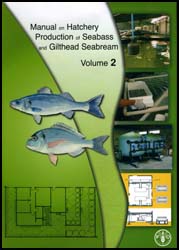Manual on Hatchery Production of Seabass and Gilthead Seabream Volume 2
FAO

Seabass and gilthead seabream are the two marine fish species which have characterized the development of marine aquaculture in the Mediterranean basin over the last three decades. The substantial increase in production levels of these two species, initially of very high value, has been possible thanks to the progressive improvement of the technologies involved in the production of fry in hatcheries. As a result of this technological progress, more than one hundred hatcheries have been built in the Mediterranean basin, working on these and other similar species. At present the farmed production of these two species derived from hatchery produced fry is far greater than the supply coming from capture fisheries.
The development of these techniques, based originally on Japanese hatchery techniques, has followed its own evolution and has resulted in what could be called a Mediterranean hatchery technology that is still evolving to provide higher quality animals and to reduce the costs of production. This is a dynamic sector but it has reached a level of maturity which merits the production of a manual for hatchery personnel that could be of interest in other parts of the world. The preparation of the manual has taken several years, and due to recent developments has led to substantial revisions of sections. The manual is not intended to be a final word in hatchery design and operation but rather a publication to document how the industry works. The authors have preferred to include proven procedures and designs rather than to orient this publication to research hatcheries that are not yet the standard of the sector.
The manual has been divided in two volumes. The first one was finalized in 2000, and covered historical background, biology and life history of the two species, especially hatchery production procedures. This second volume is divided in four parts. In the first, it tries to cover the aspects related to hatchery design and construction, from site selection to hatchery layout, and description of the various sections of a commercial hatchery. The second part covers engineering aspects related to the calculation and design of seawater intakes, pumping stations, hydraulic circuits, and pumping systems. The third part deals with equipment in the hatcheries such as tanks, filters, water sterilizers, water aeration and oxygenation, temperature control, and auxiliary equipment. The last part covers financial aspects. This section, rather than explaining the way to calculate cash flows, tries to highlight aspects that managers and investors should consider when entering this business. Volume two also includes a series of technical annexes, and a glossary of scientific and technical terms used in the two volumes.
"Tài liệu điện tử trên trang tepbac được chia sẻ để sử dụng cho mục đích học tập và nghiên cứu cá nhân. Nghiêm cấm mọi hình thức sao chép, in ấn phục vụ các mục đích khác nếu không được sự chấp nhận của tác giả và nhà xuất bản."









